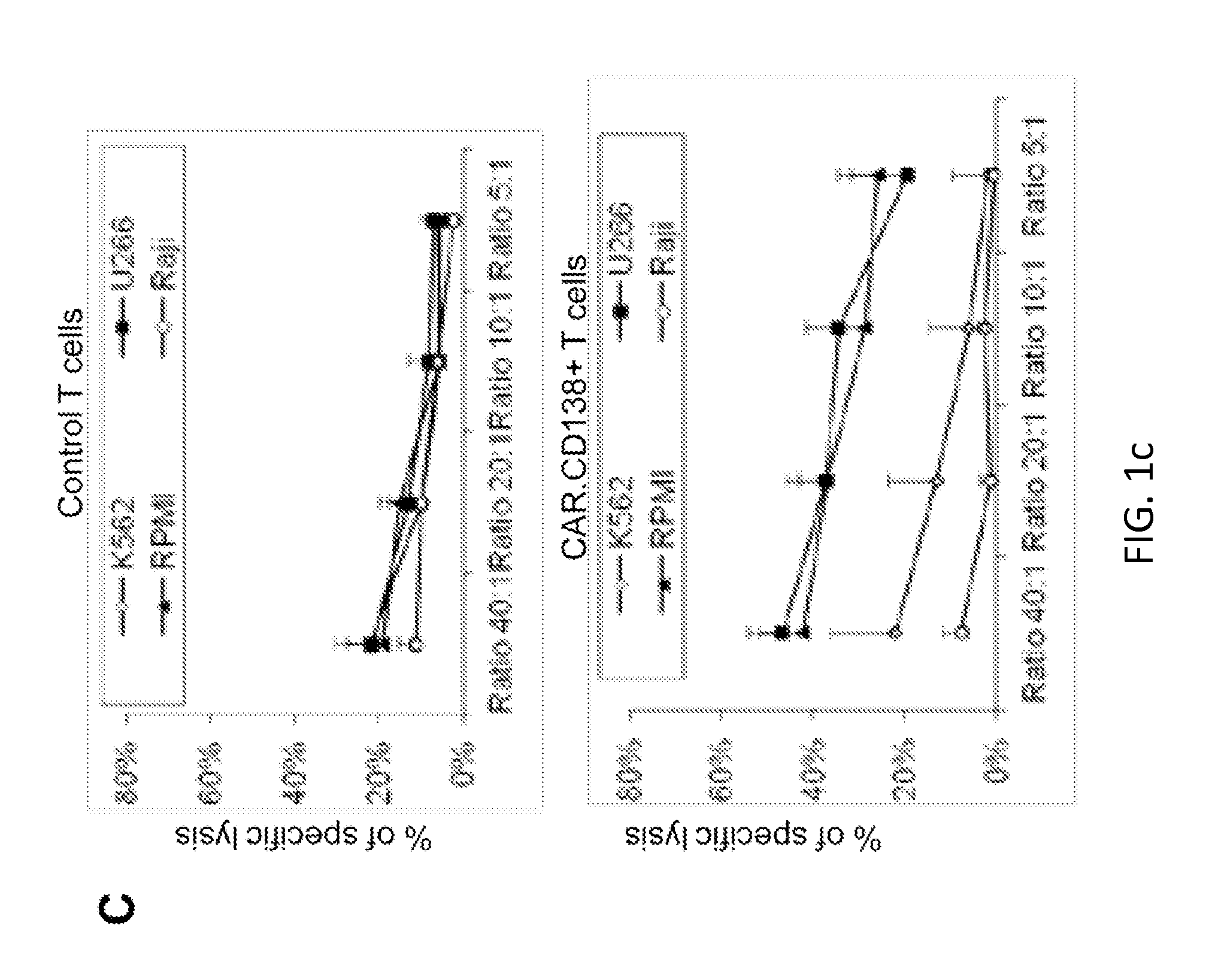Targeting cd138 in cancer
a technology of cd138 and cancer, applied in the field of cancer treatment, can solve the problem that cancer may be refractory to treatment, and achieve the effect of reducing the risk of cancer
- Summary
- Abstract
- Description
- Claims
- Application Information
AI Technical Summary
Benefits of technology
Problems solved by technology
Method used
Image
Examples
example 1
Initial Studies
XII. Initial Studies / Preliminary Data
[0195]Clinical Trials have been Developed that Target CD19, the κ-Light Chain of human immunoglobulins and CD30 in lymphomas using CAR-based technology. The strategies are under clinical investigation, and they recently reported the first group of patients treated with CAR.CD19. In embodiments of the present disclosure, CAR technology is used to target an exemplary hematological disorder that has not yet been selected for treatment by this approach.
[0196]CAR.CD138-Redirected T Cells Target CD138+Malignant PC.
[0197]The inventors cloned a CD138-specific single chain (scFv) in frame with the IgG1 hinge-CH2CH3 regions, CD28 endodomain and ζ-chain (2nd generation CAR) as previously described. FIG. 1 illustrates the expression of the CAR.CD138 in activated T lymphocytes and their specific killing of CD138+ MM cell lines (U266 and RPMI) and primary neoplastic PC.
[0198]CAR.CD138+ T Cells Control MM Growth In Vivo.
[0199]To evaluate the anti...
example 2
Exemplary Methods
[0202]Several methods used routinely are described fully in previous publications (9, 25).
[0203]In embodiments of the disclosure, there is exploitation of the hypoxic nature of MM BM microenvironment by expressing the CAR.CD138 under the inducible control of hypoxia-responsive elements (HRE). One can also define the most advantageous immune elements for costimulation of CAR T cells in a hypoxic environment both in vitro and in vivo in a Xenogenic mouse model. Finally, to further increase the safety of the proposed approach, the skilled artisan can incorporate within a construct a previously validated suicide gene based on inducible caspase9 (iC9).
[0204]The initial studies (FIGS. 1 and 2) clearly indicate that T cells that constitutively express CAR.CD138 have anti MM effects both in vitro and in vivo in xenotransplant mouse model. As shown in FIG. 3, hCAR.CD138 is significantly upregulated when T cells are exposed to hypoxia, and these cells retain anti-MM activity....
example 3
Study of T Cells Expressing CD138-Specific Car for Advance Plasma Cell Dyscrasias
[0214]In embodiments of the disclosure, one can evaluate the safety of escalating doses of autologous or syngeneic activated peripheral blood T lymphocytes (ATLs) genetically modified to express (a) an artificial T-cell receptor (chimeric antigen receptor or CAR) targeting the CD138 molecule (CD138.CAR) under an hypoxia-dependent promoter, and (b) a inducible caspase-9 (iC9) suicide protein under a constitutively active promoter. Specific embodiments of methods of the disclosure include (1) measuring the survival and function of these CD138.CAR-ATLs in vivo; (2) quantifying the anti-tumor effects of CD138.CAR-ATLs in patients with refractory plasma cell dyscrasias, with clinical responses assessed by the modified International Myeloma Working Group (IMWG) Uniform Response criteria; and (3) evaluating the efficacy of the administration of AP1903, a dimerizer used to activate the suicide gene, by measurin...
PUM
| Property | Measurement | Unit |
|---|---|---|
| time | aaaaa | aaaaa |
| weight | aaaaa | aaaaa |
| weight | aaaaa | aaaaa |
Abstract
Description
Claims
Application Information
 Login to View More
Login to View More - R&D
- Intellectual Property
- Life Sciences
- Materials
- Tech Scout
- Unparalleled Data Quality
- Higher Quality Content
- 60% Fewer Hallucinations
Browse by: Latest US Patents, China's latest patents, Technical Efficacy Thesaurus, Application Domain, Technology Topic, Popular Technical Reports.
© 2025 PatSnap. All rights reserved.Legal|Privacy policy|Modern Slavery Act Transparency Statement|Sitemap|About US| Contact US: help@patsnap.com



